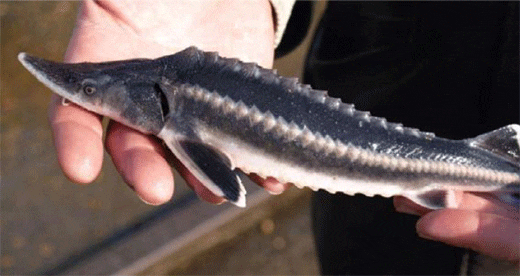An increasing number of fish are finding their way onto the CITES3 lists of endangered species. The production of juvenile fish and shellfish in hatcheries is far more efficient (in terms of survival) than in the wild. These juveniles may not only be grown on as food, but also for the conservation and restoration of fish populations (through release or restocking) and the provision of fish for angling.
This technique, also known as “stock enhancement” or “enhancement aquaculture” has an economic advantage in that production costs are much lower, and has proven to be successful for a variety of marine fish species, mainly in Norway, Japan and the USA.

Sturgeons are among the world’s most valuable wildlife resources and can be found in large river systems, lakes, coastal waters and inner seas throughout the northern hemisphere. For people around the world, caviar, i.e. unfertilized sturgeon roe, is a delicacy. Sturgeons are also a major source of income and employment, as well as an important element of the local food supply. Current trends in illegal harvest and trade put all these benefits at risk. Since 1998, international trade in all species of sturgeons has been regulated under CITES owing to concerns over the impact of unsustainable harvesting of and illegal trade in sturgeon populations in the wild.
The Ramsar Declaration on Global Sturgeon Conservation recognises the importance of aquaculture in the preservation of sturgeon species, specifically mentioning the importance of captive broodstock programmes to prevent loss of genetic variety; the monitoring of stocked juvenile fish to assess the cost-effectiveness of stocking strategies; the cultivation of sturgeon for meat and caviar products – especially with due involvement of the lowincome local fishing community who need alternative livelihoods; and the need for internationally agreed standards on culture technology and general husbandry, adequate nutrition, disease prevention and product quality control.
More information is available at www.wscs.info – the site of the World Sturgeon Conservation Society.
Different trout species have been restocked in Europe’s rivers for decades. Prior to the Second World War, the UK production of trout juveniles was exclusively to stock rivers in England and Scotland to support natural populations and for recreational fishing. It was only in the 1950s that technology was introduced to produce fish for the table. This is the case across much of Europe, where trout remains the top aquaculture production species within European Member States, and where restocking accounts for a significant proportion of total trout fry production.

3 CITES (the Convention on International Trade in Endangered Species of Wild Fauna and Flora). www.cites.org
November 2008



